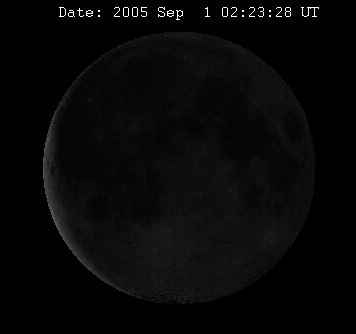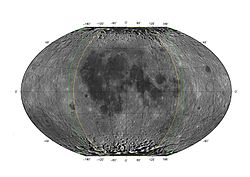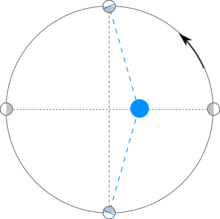天平动



在天文学中,天平动(英语:Libration)是从卫星环绕的天体上观察所见到的,真实或视觉上非常缓慢的振荡。[1]尽管这些振荡亦适用于其他行星,甚至太阳,但天文学家们长久以来都只用在月球相对于地球的视运动,并且选择一个点来平衡与对比晃动的尺度。[2]
月球的天平动
“天平动”的英语名称“英语:Libration”源自拉丁文词汇“libra”,意思是“尺度”(古罗马量度单位)。其动词为“libro -are”,意思为“摇摆中的平衡”。[3]
虽然月球自转已经是同步锁定于绕着地球的公转,但这些轻微的摆动让地面的观测者在不同的时间能看见些许不同的月球表面。这意味着人类在地球上能观测到59%的月球表面,而非仅仅是月球正面。[4]
月球天秤动共有四种形式区分:纬度天平动、经度天平动、周日天平动和物理天平动。部分天文年历能够查看到每个月期间月球天平动的数据。[5]
经度天平动
经度天平动 是月球绕着地球公转的轨道有少许的离心率造成的结果。当月球由近地点向远地点移动时轨道速度逐渐减慢,由远地点向近地点移动时速度逐渐加快,但月球的自转速度始终不变,所以月球在轨道上的位置有时超前、有时落后自转的速度。在月球赤道上每一度相当30公里,所以 经度天平动可以使我们在东西侧多观察到约235公里的月面。这虽然不是很大的地区,但是我们看见的正对地球的点将因而改变。[6]
- 经度天平动 :±7 º 45'
纬度天平动
纬度天平动是月球自转轴的法线对月球绕地球的轨道平面有少许的倾斜造成的,其起源类似于地球公转太阳时造成季节变化的现象。月球的自转轴相对于“黄道”的倾斜角为1.54 º,黄白两道的交角为5.14 º,因此纬度天平动的最大值为±6.7 º,相当于在南北极方向约200公里的距离。[7]
- 纬度天平动:±6 º 41'
周日天平动
周日天平动影响较小,是地球自转所造成,它使地面上的观测者从地月中心连线的西侧转至东侧,因而先多看见一些月球的东侧,然后多看见一些月球的西侧。地月的平均距离38万公里,地球半径6,378公里,地球的自转将使观测者最多能在赤道的东西侧多看见约30公里的区域。[8]
- 周日天平动:±1 º
物理天平动
不同于前面三种,这是月球真正的摆动。由于月球的三条主惯性轴长度不等,加上椭圆轨道造成的距离改变,在地球引力作用下,发生对平均位置的偏移。但是物理天平动比几何天平动小得多,它的摆动从未曾大于0.04 º,所以一般都忽略不予考虑。此外,月球上的“月震”也会影响到月球上正对地球的点。[9]
特洛伊天平动
|
参见:马蹄形轨道 |
于1772年,意大利天文学家约瑟夫·拉格朗日完成关于马蹄轨道的研究并指出,如果一个小天体位于轨道上的拉格朗日点(行星位置前方或后方60°)时,它就能与一个行星共享一个轨道。这些小天体被称为“特洛伊天体”(Trojan asteroids)。至今,天文学家们已于地球、木星、火星和海王星的轨道上发现特洛伊天体。位于地球轨道上的特洛伊天体在可见光下很难被观察到,因为其与地球的相对位置令到它只会在日间的天空出现,所以无法被观察。[10]但是,天文学家于2010年透过使用红外线观测技术,发现小行星2010 TK7是地球的特洛伊天体,位于地球前方的L4拉格朗日点[锚点失效],并且有着一个稳定的轨道。[6]
原理
 |
 |
 |
 |
参考文献
- ^ Computation of the Quantities Describing the Lunar Librations in The Astronomical Almanac - D.B. Taylor and S.A. Bell, HM Nautical Almanac Office J.L. Hilton, US Naval Observatory A.T. Sinclair, HM Nautical Almanac Office, retired (PDF). [2013-12-14]. (原始内容存档 (PDF)于2020-02-15).
- ^ WWU Planetarium - Lunar Libration - Western Washington University. [2013-12-14]. (原始内容存档于2017-02-19).
- ^ Earth Moon Libration Points - Permanent. [2013-12-14]. (原始内容存档于2020-04-18).
- ^ the-moon - Librations. [2013-12-14]. (原始内容存档于2020-04-18).
- ^ Frequency-Dependent Characteristics of the EME Path Joe Taylor, K1JT. [2013-12-14]. (原始内容存档于2021-02-26).
- ^ 6.0 6.1 Connors, Martin; Paul Wiegert & Christian Veillet. Earth’s Trojan asteroid. Nature (Nature). 28 July 2011, 475: 481–483 [1 August 2011]. Bibcode:2011Natur.475..481C. PMID 21796207. doi:10.1038/nature10233.
- ^ J. D. Mulholland, E. C. Silverberg. Measurement of Physical Librations Using Laser Retroreflectors. Earth, Moon, and Planets. 1972, 4 (1-2): 155–159. Bibcode:1972Moon....4..155M. doi:10.1007/BF00562923.
- ^ diurnal libration - Oxford Index - Oxford University Press. [2013-12-14]. (原始内容存档于2019-12-07).
- ^ Moore, Sir Patrick. Philip's Atlas of the Universe. Foreword by Sir Arnold Wolfendale. Philip's. 2003. ISBN 978-0-540-08707-5. OCLC 51966591.
- ^ Christou, Apostolos A.; Asher, David J. A long-lived horseshoe companion to the Earth. Preprint. 2011. Bibcode:2011MNRAS.414.2965C. arXiv:1104.0036
 . doi:10.1111/j.1365-2966.2011.18595.x.
. doi:10.1111/j.1365-2966.2011.18595.x.
外部链接
- 每日一天文图(英文) (页面存档备份,存于互联网档案馆)
- 每日一天文图(中文)
- Applet plot图解(英文) (页面存档备份,存于互联网档案馆)
- National Maritime Museum - A discussion the components of libration of the Moon with diagrams (on page 2)
| ||||||||||||||||||||||||||||||||||||||||||||||||||
Text is available under the CC BY-SA 4.0 license; additional terms may apply.
Images, videos and audio are available under their respective licenses.

